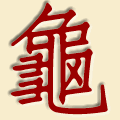 (guī) , noun = tortoise, turtle
(guī) , noun = tortoise, turtle
This is my favorite Chinese character and one of the few that sort of resembles the word it represents. At the top you have the head, then the two bits sticking out on the left are the claws, the shell is on the right and at the bottom is the tail. If I hadn’t told you this though, I doubt if you would have guessed the meaning of this character.
The turtle is a symbol of longevity, strength, stability and prophecy in Chinese culture. The idea that the world is supported by a giant turtle appears in stories in many cultures.
By the way, in case you’re wondering, the Chinese character at the top of this page means character, letter or word and is pronounced zì in Mandarin Chinese, ji in Japanese and ja in Korean.
Cheers to the blog, Simon!
And to stump the occasional Chinese speaker…
This character is pronounced jun1 in 龜裂 jun1 lie4 meaning crack, fissure, or fault.
In Japanese, this character is simplified to 亀, and is pronounced as “ki,” “kame,” or “hisa.” I always find it interesting to learn the original Chinese pronunciation of a character after knowing the “on-yomi” or “Chinese reading” pronunciation in Japanese. In this case, “gui” became “ki.”
The relationship between Chinese and Japanese On’yomi is pretty interesting. I think it’s a safe assumption that, since most linguists agree that Chinese characters entered Japan some 1500 years ago, that their modern pronunciation in Japan is decended from a dialect of Chinese that has gone out of use. I’d say that is why some characters have closer pronunciation than others. For example 練習 is pronounced lian4 xi2 in mandarin and renshuu in Japanese. 国 however is pronounced guo2 in Mandarin and koku in Japanese… a bit more distant.
This character actually also reminds me of “dragon” in hanzi which I guess, as it is with tortoise, resembles the shape or the origin of the word. But maybe dragon has more uses than tortoise? It is quite obvious in the puzzles page where repetitive form of “dragon” can have many several meanings!
By the way maybe I’m not learning chinese but quite fond of their art in writing, specially that chinese characters are one of the few writing systems that indeed resemble and transfer the philosophical thought of the writer or the ancestors who invented those characters. Check out how they write “eveil soul” in kanji or hanzi!!
this character is also the second-to-last radical in most dictionaries, (making it easy to find), and therefore the second most complex radical with 16 strokes. one variation, pronouned “bie” also means “turtle”, but takes a total of 28 strokes to write.
The kun reading of “hisa” for the character is used for personal names usage and it means “long time”. Kame, (turtle-tortoise) is the symbol of longetivity, because of their long lifespan.
In reply to Jason Liekhus’ remark about the relationship between Japanese and archaic Chinese, the proof of such relation lies in the similarity of Japanese on’yomi readings with Cantonese (dialect spoken in the south of China), more than with Mandarin (official Chinese, mainly spoken in the north).
Three examples:
万 (“10,000”, “myriad”, “multitude”) reads wan in Mandarin, man in both Cantonese and Japanese (ban and yorozu are alternative Japanese readings).
人 (“person”) reads ren in Mandarin, jan in Cantonese, jin in Japanese (nin and hito are alternative readings).
門 (“gate”) reads men in Mandarin, mun in Cantonese, mon in Japanese (kado is the alternative reading).
The reason for this is that by the time Japan imported glyphs from China, the south of the latter country was inhabited mostly by peasants, who were illiterate. A literacy campaign was then enforced by the central government, and teachers were sent to the southern provinces.
In time, the language spoken in the north of the country underwent considerable changes, whereas the southern dialect (Cantonese) was affected by this evolution in a much slighter degree. This is why today several Japanese on’yomi readings are similar to Cantonese ones.
I was told this version of the story by a friend from China, who has a particular interest in Chinese linguistics.